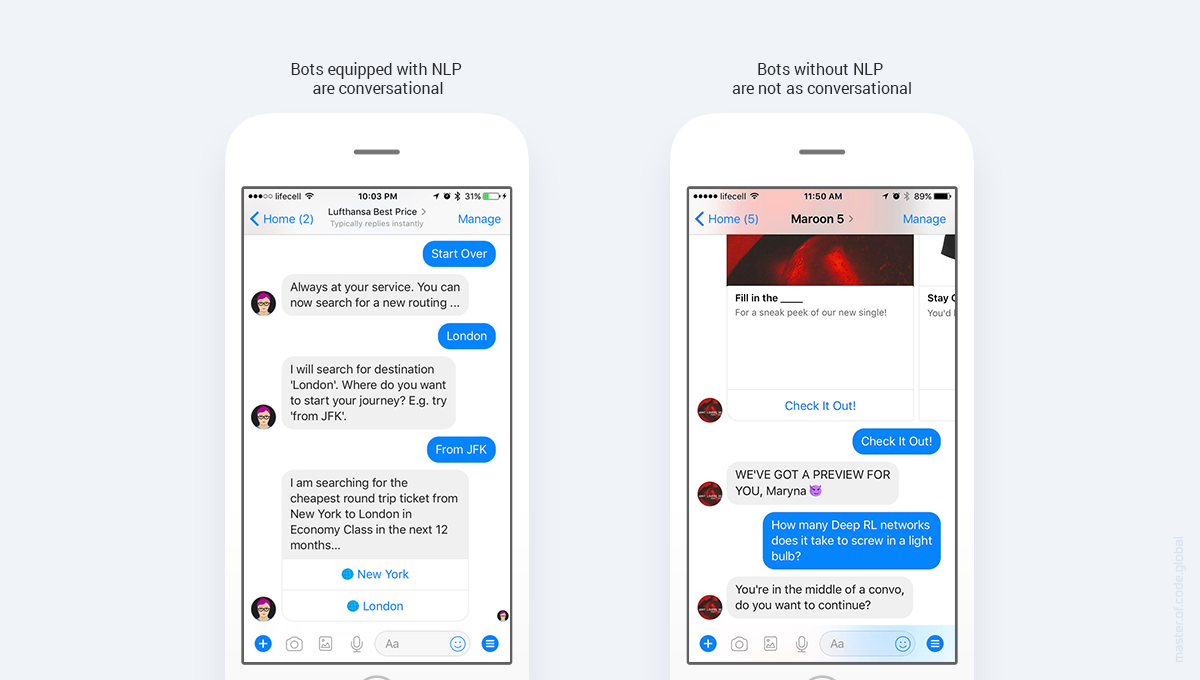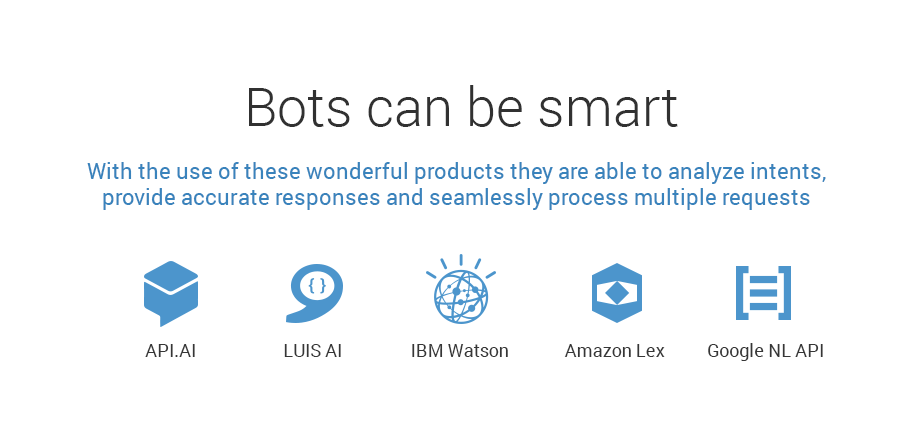Not all chatbots are created equal. There are many factors in which bots can vary, but one of the biggest differences is whether or not a bot is equipped with Natural Language Processing or NLP.
Natural Language Processing is a way for computer programs to converse with people in a language and format that people understand. This involves features including natural language understanding (understanding what the user is saying), natural language processing (replying to the user in a logical way), and sentiment analysis (the ability to understand the user’s tone and intent).

NLP powered chatbots require AI, or Artificial Intelligence, in order to function. They engage with users in a way that a human would. These bots require a significantly greater amount of time and expertise to build a successful bot experience.
Read also: Customer Service. What Can Bots Actually Do?
Bots without Natural Language Processing rely on buttons and static information to guide a user through a bot experience. They are significantly more limited in terms of functionality and user experience than bots equipped with Natural Language Processing. These bots are useful for various tasks, including sales.
Let’s take a look at the benefits of bots with Natural Language Processing, shall we?
Time Savings Means a Positive Change in Focus
NLP powered chatbots decrease the time and resources that are traditionally required for various organizational functions, including customer support, invoice processing, catalog management, and human resource management. This reduction is also accompanied by an increase in accuracy, which is especially relevant for invoice processing and catalog management, as well as an increase in employee efficiency.
This increase in employee efficiency comes in two primary ways: first, by decreasing the number of monotonous task your employees have to perform and second, by making your employees better at their jobs. Internal chatbots can serve as a user-friendly database for your organization. Instead of your new, or even experienced employees emailing their bosses a “quick question” that has been answered in the past, they can simply ask the bot. This results in an instantaneous answer, and time savings across your organization. When you think about how many emails are sent daily, and how many of those are simple inquiries, the benefits of an internal Natural Language Processing bot are quite clear.
Recently AccentureStrategy worked with a global life sciences company that generated savings via implementation of a digital procurement function. Procurement leadership reinvested 10 percent of the savings generated by reallocating headcount, dedicating them to strategic supplier relationship management.
The reallocation of resources by the global life sciences company is allowing them to establish deeper connections with their current strategic suppliers, as well as find additional strategic suppliers. Time will tell how much of a positive impact this move creates for the company.
Cost Reduction Means Increased Margins
While AI chatbots do have a plethora of other benefits, cost reduction is an important one to note. These cost savings come in two primary ways: decreased payroll costs as well as decreased customer acquisition and retention costs. AI chatbots increase efficiencies and inspire innovative thinking across your organization, as well as help improve the quality of various processes, including customer service.
Chatbots are able to deal with customer inquiries at-scale, from general customer service inquiries to the start of the sales pipeline. NLP-equipped chatbots tending to these inquiries allow companies to allocate more resources to higher-level processes (for example, higher compensation for salespeople). A percentage of these cost savings can be simply kept as cost savings, resulting in increased margins and happier shareholders. Decreased costs and improved organizational processes are both competitive advantages for your organization, which is more important now than ever before.
We believe that health care and banking providers using bots can expect average time savings of just over 4 minutes per inquiry, equating to average cost savings in the range of $0.50-$0.70 per interaction.
These savings per inquiry add up quickly, and according to Juniper Research, they could total $8 billion in savings per company annually by the year 2022. Current chatbot metrics, as well as future projections both, show the importance of chatbots to organizations. If you don’t have a chatbot yet, what are you waiting for?
More Efficient Service Means Happier Customers
As I stated in a previous blog post, bots can take care of customer inquiries quickly and efficiently. This leads to happier customers who stay loyal to your company. The cost to acquire a new customer is significantly higher than the cost to keep your current customers, so this is important. Customers want to feel important, and they want to know that they are being heard. Chatbots can take care of that.

NLP chatbots can, in the majority of cases, help users find the information that they need more quickly. This is in comparison to their non-NLP chatbot counterparts. Users can ask the bot a question or submit a request; the bot comes back with a response almost instantaneously. For bots without Natural Language Processing, a user has to go through a sequence of button and menu selections, without the option of text inputs.

The power of NLP bots in customer service goes beyond simply replying to a user in a literal sense. NLP-equipped chatbots, outfitted with the power of AI, can also understand how a user is feeling when they type their question or remark. Happy users and not-so-happy users will receive vastly varying comments depending on what they tell the chatbot. Chatbots may take longer to get sarcastic users the information that they need, because as we all know, sarcasm on the internet can sometimes be difficult to decipher.
We use a variety of tools to build AI chatbots, including LUIS by Microsoft.

For example, LUIS does such a good job understanding and responding to user intents.

Human-like Engagement Means Increased User Engagement
What makes a Chatbot a good Chatbot is the same thing that makes a good salesperson a good salesperson: asking the right questions and knowing their products and services. When people message a company and encounter a chatbot, they want to be able to get the information that they need right when they want it. This is a factor that impacts user engagement.
Arte Merritt, CEO and Co-Founder Dashbot.IO:
Across Facebook chatbots in general, if the percentage of buttons and messages is more than one standard deviation above the average, the engagement is about half the engagement when it’s one standard deviation below the average.
In other words: the more steps you have to go through to get your answer, the less likely you are to actually engage than you would if you had to ask less questions and go through less steps. This is pretty intuitive if we think about our own experiences online shopping, or even shopping in general. The less steps you make your users go through to find their desired information, the more successful your chatbot will be. This is where freeform text inputs and NLP powered chatbots come in handy: giving users the option to talk to your chatbot in the same way they would talk to their friends and family increases engagement in a variety of industries.
You can use different chatbot analytics tools, including tools such as BotAnalytics, to get a more comprehensive view into how your chatbot is performing. Using analytics lets you understand how users are using your chatbot and optimizing their experience, thus improving engagement.
Conclusion
Chatbots equipped with Natural Language Processing can help take your business processes to the next level and increase your competitive advantages. The benefits that these bots provide are numerous and include time savings, cost savings, increased engagement, and increased customer satisfaction.
Master of Code designs, builds, and launches exceptional mobile, web, and conversational experiences.






